Synth bass sounds are an integral part of modern music production.
They can add depth, rhythm, and character to a track, transforming a simple melody into a compelling track.
Plus, it can provide a solid foundation for complex arrangements.
Synth bass sounds also offer a broad spectrum of tonal possibilities, from deep and resonant to sharp and cutting, as well as the flexibility to fit into any musical genre.
So, as a music producer, it’s important to know all about synth bass sounds to enhance your tracks and engage your audience.
In today’s article, we’ll be breaking down:
- The basics of synth bass ✓
- Different types of synth bass sounds ✓
- Characteristics of popular synth bass types ✓
- Techniques for crafting bass lines ✓
- Using filters and waveforms ✓
- Advanced synthesis methods ✓
- Setting up synthesizers for optimal bass production ✓
- Practical mixing and balancing tips ✓
- Much more about synth bass sounds & tricks ✓
After this article, you’ll have a solid understanding of the different types of synth bass sounds and how to incorporate them.
This way, you can create rich and dynamic bass lines that elevate your music.
You’ll be able to master synth bass production with ease and produce sounds that capture your listeners’ attention 一 making your music shine.
So, let’s dive in…
Table of Contents
Understanding Synth Bass
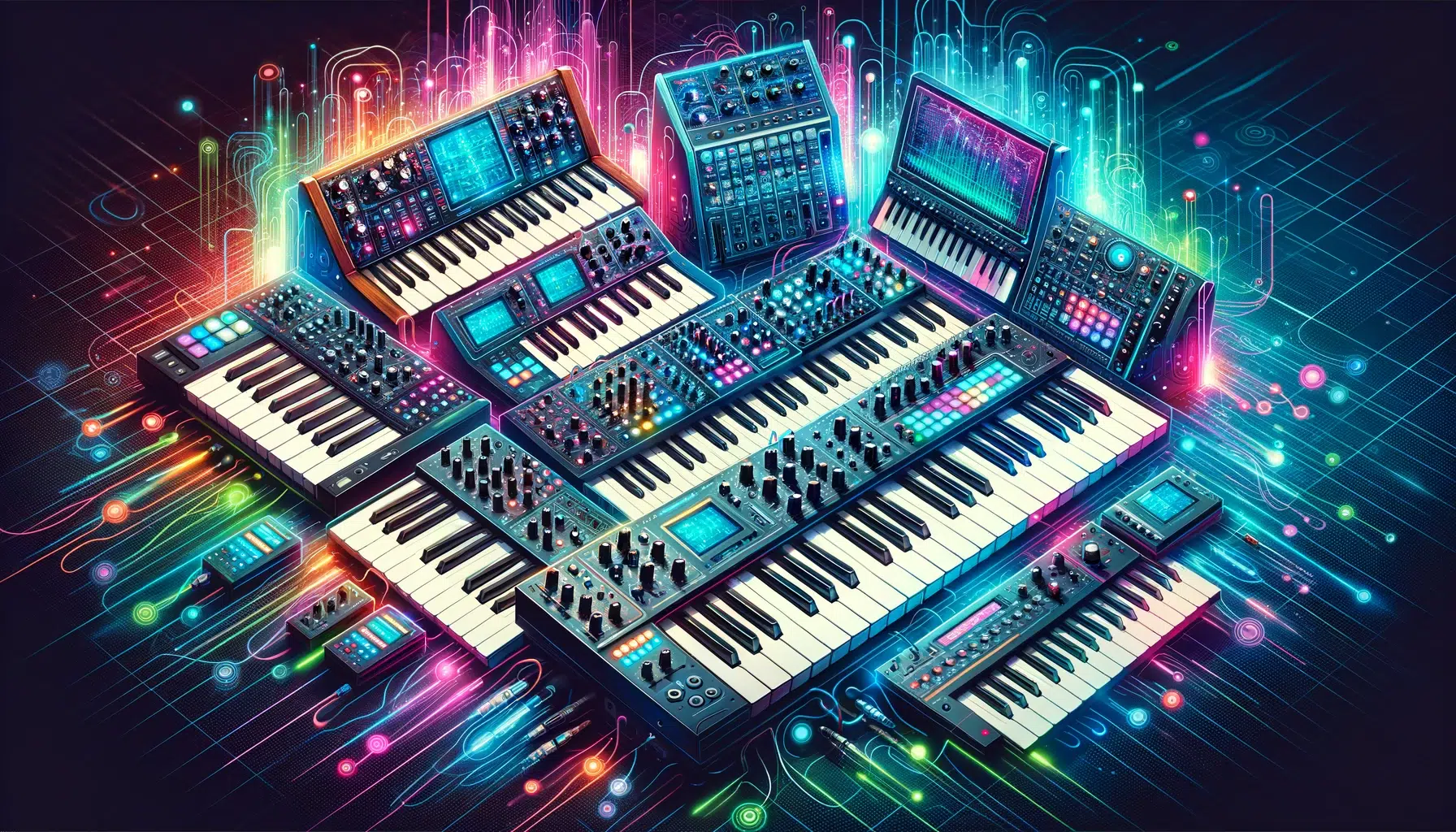
Synth bass is a fundamental sound element in modern music production, providing the backbone for many genres like hip-hop, pop, and electronic music.
Achieving that classic synth bass sound is all about producing low-frequency sounds using synthesizers.
These sounds form the rhythmic and harmonic foundation of a track 一 offering both depth and energy when they’re heard.
Understanding how to effectively use synth bass is crucial for any music producer, as it greatly influences the overall feel and dynamics of the music.
The role of synth bass in music production has evolved significantly with advancements in synthesizer technology.
From the classic analog bass sounds of the past to the complex digital bass tones of today, the range and capabilities of synth bass sounds have expanded.
This allows you to experiment with a variety of tones and textures to create the desired impact in your tracks, like:
- Smooth, sine-wave-based sounds
- Aggressive square-wave-based sounds
- Everything in between
To master synth bass, it’s important to understand its interaction with other musical elements.
A well-constructed synth bass line can elevate any given track, ensuring that it resonates when people listen.
NOTE: You’ll need to consider how the bass interacts with drums, melodies, and other harmonies (and adjust accordingly) to create a balanced and engaging sound.
Exploring Popular Synth Bass Types
Now let’s dive deeper into some of the most popular types of synth bass sounds that have defined genres and influenced countless tracks.
#1. FM Bass
FM Bass, a product of FM synthesis, stands out for its distinctive sound that has left a permanent mark on various music genres.
Frequency modulation is an innovative synthesis technique used in sound design and music production.
Frequency modulation is where the frequency of one waveform (called the carrier) is modulated by another waveform (known as the modulator).
This process creates complex overtones and rich timbres, allowing for the creation of unique and intriguing new sounds.
FM synthesis is particularly noted for its ability to produce sharp, cutting bass sounds and intricate, bell-like tones.
By carefully manipulating the parameters in FM synthesis, you can create a metallic timbre in your synth bass.
This will add a distinct, edgy character to your tracks that stand out in the mix.
These metallic timbres have become a signature element in tracks across genres 一 you can hear them in electronic music and pop music.
The versatility of FM Bass lies in its ability to produce a wide range of sounds, like:
- Deep and warm
- Bright and edgy
This flexibility makes it a go-to choice for producers looking to inject a dynamic element into their tracks.
Plus, the ability to fine-tune the modulation parameters allows for the creation of a spectrum of sounds, each with its unique character.
You can hear examples of FM Bass in classic tracks where the bass line takes center stage, like “24K Magic” by Bruno Mars (shown above).
The application of FM bass extends beyond just the sound itself…
It’s about how the FM Bass interacts with other elements in the mix, contributing to the overall texture and feel of the track.
#2. Dubstep Wobble Bass
The Dubstep Wobble Bass is a hallmark of the dubstep genre.
It’s renowned for its unique ‘wobble’ effect that adds an intense, rhythmic quality to the bass line (think bass guitar).
This effect is achieved through the manipulation of low-frequency oscillators, known as LFOs, and filters.
It creates a sound that is both aggressive and captivating.
The wobble bass has become synonymous with the dubstep genre, defining its sound and energy 一 its pulsating rhythm and thick texture have a hypnotic effect.
Creating a Dubstep Wobble Bass requires a blend of production skill and creative vision.
You can achieve mind-blowing wobble effects by adjusting parameters, like:
- The rate of the LFO (low-frequency oscillator)
- The intensity of the filter cutoff
- The resonance
This versatility allows the wobble bass to fit not just in dubstep but also in other genres, adding a unique twist to traditional bass sounds.
The key is to find the sweet spot where the wobble complements the track’s groove, enhancing the overall listening experience.
#3. Reese Bass
The Reese Bass, with its thick, chorused sound, is a staple in genres like drum and bass and hip-hop.
Originating from the classic track ‘Just Want Another Chance’ by Kevin Saunderson, this bass sound is characterized by its detuned saw or square waves.
It creates a rich playing texture that is super intriguing and unique.
The Reese Bass is not just about the sound itself; it’s about the atmosphere it creates, captivating audiences of all kinds.
When creating a Reese Bass, the focus is on layering multiple oscillators slightly detuned from each other to achieve that signature sound.
- The use of a low-pass filter 一 Controls the harshness of the high frequencies.
- The envelope settings 一 Shapes the attack and decay of the sound.
The result is a bass that stands out in the mix and will make your listeners want to play your tracks on repeat.
It provides a solid foundation for tracks that demand a powerful low-end (which we’re all aiming for).
#4. Acid Bass
Acid Bass, a defining element of acid house music, is renowned for its squelchy, resonant sound that has captivated audiences since the 1980s.
This distinctive bass sound is created using a specific type of synthesizer (often featuring a diode ladder filter design) which contributes to its unique tonal quality.
The Acid Bass is more than just a sound 一 it has revolutionized dance music.
The creation of Acid Bass involves manipulating the filter cutoff and resonance controls in real time, giving it a dynamic and expressive quality.
The use of a step sequencer for programming bass lines adds to the characteristic rhythmic patterns associated with acid house.
This type of bass sound demands attention, cutting through the mix with its piercing timbre and bringing raw energy to tracks.
#5. 808 Bass
The 808 Bass, originating from the iconic Roland TR-808 drum machine, has become a fundamental element in genres like hip-hop, trap, and pop music.
Known for its deep, booming sound, the 808 Bass has shaped the sound of modern music.
Its ability to provide both a rhythmic foundation and a melodic element makes it a versatile tool in the hands of a skilled producer.
Creating an effective 808 Bass involves more than just selecting the right preset 一 it’s about fine-tuning the sound to fit the context of the track.
Make sure to:
- Adjust elements like the decay time (e.g., short decay, medium decay, moderate decay)
- Fine-tune the bass to the key of the track
- Apply effects like distortion or saturation
It can completely transform a simple 808 sound into a powerful sonic element.
The 808 Bass, with its distinctive punch and presence, is a testament to the enduring impact of vintage gear in modern music production.
#6. Octave Bass
The Octave Bass, often used in funk and disco genres, stands out for its ability to seamlessly blend rhythm and melody.
This synth bass type typically features a sound that jumps between different octaves, creating a lively and energetic feel.
The use of synthesizers to create Octave Bass lines adds a modern twist to this classic sound 一 offering a fresh perspective on traditional bass playing techniques.
NOTE: When crafting an Octave Bass line, the key is to balance the lower and upper octaves, ensuring that the bass remains prominent without overpowering the mix.
This involves careful attention to the synthesizer’s envelope settings, particularly the attack and decay, to shape the sound’s dynamics.
The result is a bass line that not only provides a solid foundation but also contributes to the track’s overall melodic structure.
Creating Hard-hitting Bass Lines
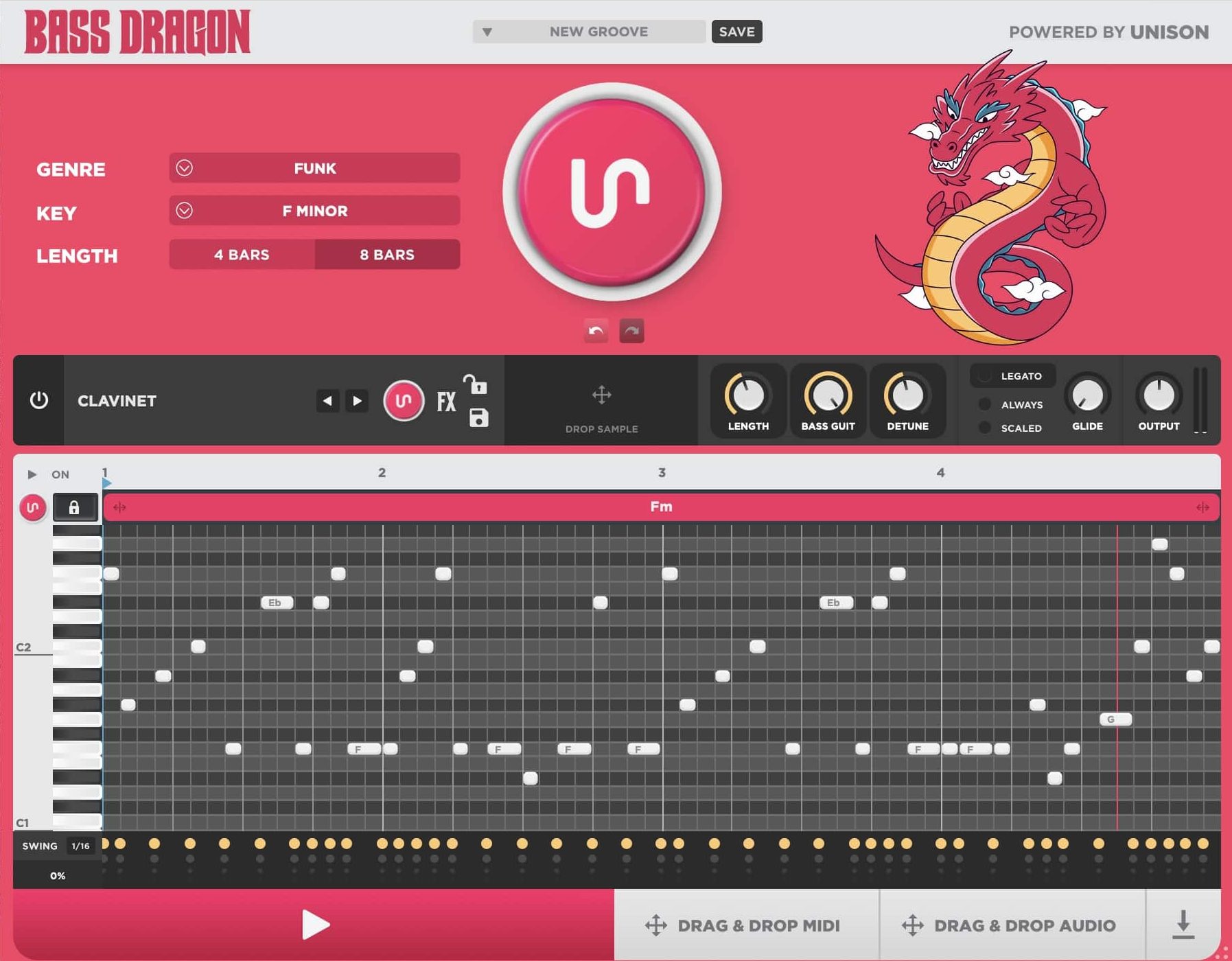
You can create hard-hitting basslines in any genre with Bass Dragon!
The art of creating hard-hitting bass lines lies in understanding the interplay between rhythm and melody.
A compelling bass line not only supports the harmonic complexity of a track but also adds a distinctive groove that can define its character.
Whether it’s a smooth electric bass in a soul track or a punchy FM bass in a techno piece, the key is to craft a line that complements the overall feel of the music.
When constructing bass lines, it’s essential to consider the interplay with other elements like drum patterns and melodies.
As well as:
- Syncopation
- Note length
- Tonal variation
They are all critical factors in making a bass line stand out.
For example, a Reese bass line in a drum and bass track often features fast, syncopated rhythms that intertwine with the drum’s complex patterns.
This will create an energetic and cohesive sound that will make people stop and listen.
Using Filters and Waves
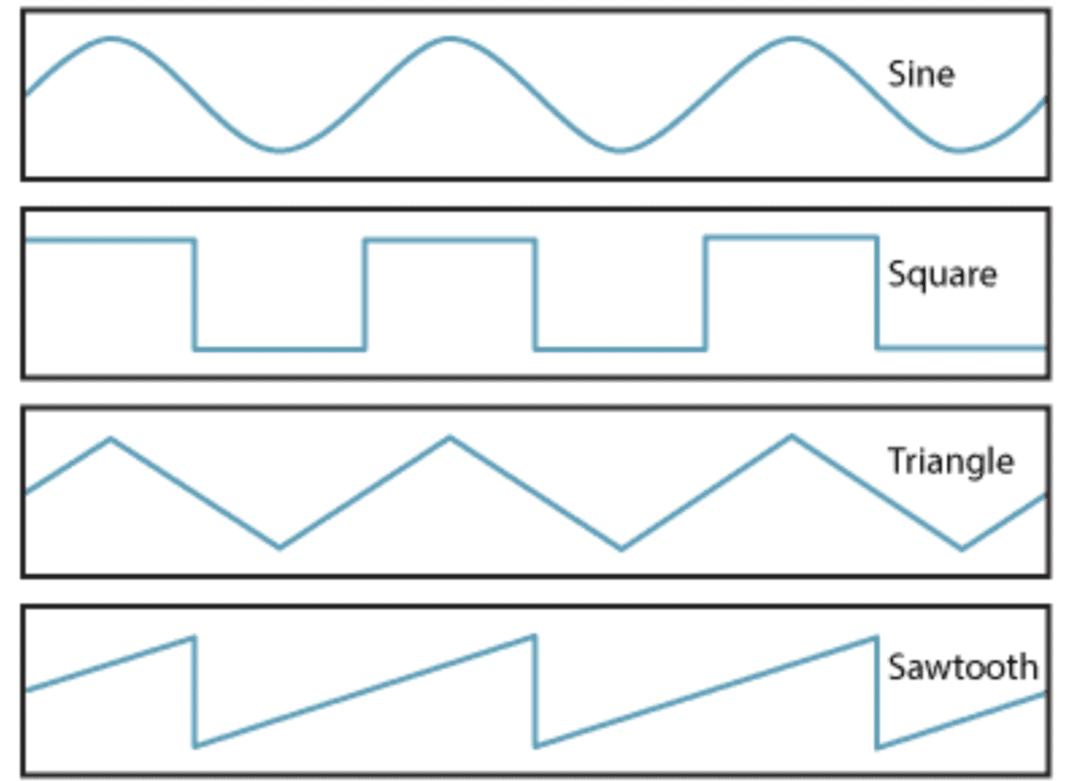
Filters and waveforms are fundamental tools in shaping the character of a synth bass sound.
A low-pass filter, for instance, can smooth out the harsher frequencies of a square wave, rendering a warmer and more rounded bass sound.
A High-pass filter might be used to accentuate the higher complex harmonics of an FM bass, giving it a more pronounced presence in the mix.
The choice of waveform (like a sine wave for a sub-bass or a saw wave for an acid bass) greatly influences the tonal quality of the bass sound.
Each waveform has its unique harmonic content.
They can be further shaped using synth techniques like frequency modulation or wave shaping.
This can help you create a wide range of bass sounds 一 from simple and subtle to complex and aggressive.
Applying these tools creatively can lead to innovative bass sounds.
For instance, blending a triangle wave with a square wave can yield a bass sound with both body and edge, suitable for genres like dubstep or electro.
Understanding how to manipulate filters and waveforms is key to unlocking the full potential of synthesizers in bass sound production.
Oscillator and Waveform Choices
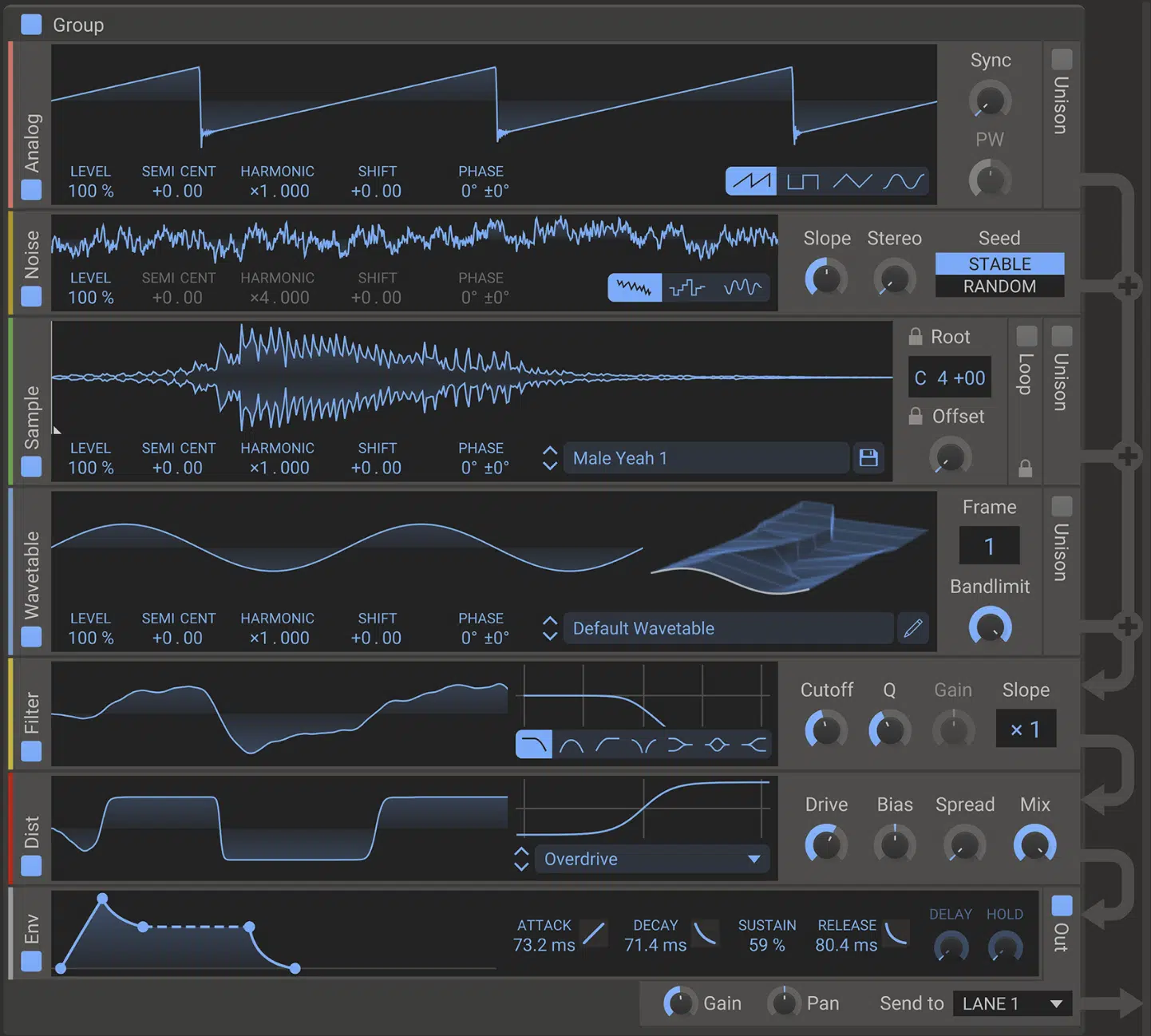
The selection of oscillators and waveforms plays a pivotal role in defining the character of a synth bass.
Choosing the right oscillator, whether it’s for an analog synth bass or a digital FM bass, can significantly impact the sound’s:
- Warmth
- Brightness
- Texture
For instance, an acid bass typically relies on a sawtooth wave for its signature sound (buzzy).
A dubstep bass, on the other hand, might combine square waves with modulation for its characteristic wobble.
Waveform manipulation is another aspect to consider.
Saw or square waves might be the foundation… but applying pulse width modulation or syncing oscillators can transform these basic waveforms.
This will produce something much more complex and engaging.
This level of control will help you tailor your bass sounds to fit the specific needs of your tracks, whether it’s for a punchy hip-hop beat or a driving techno groove.
-
Filter and Envelope Settings
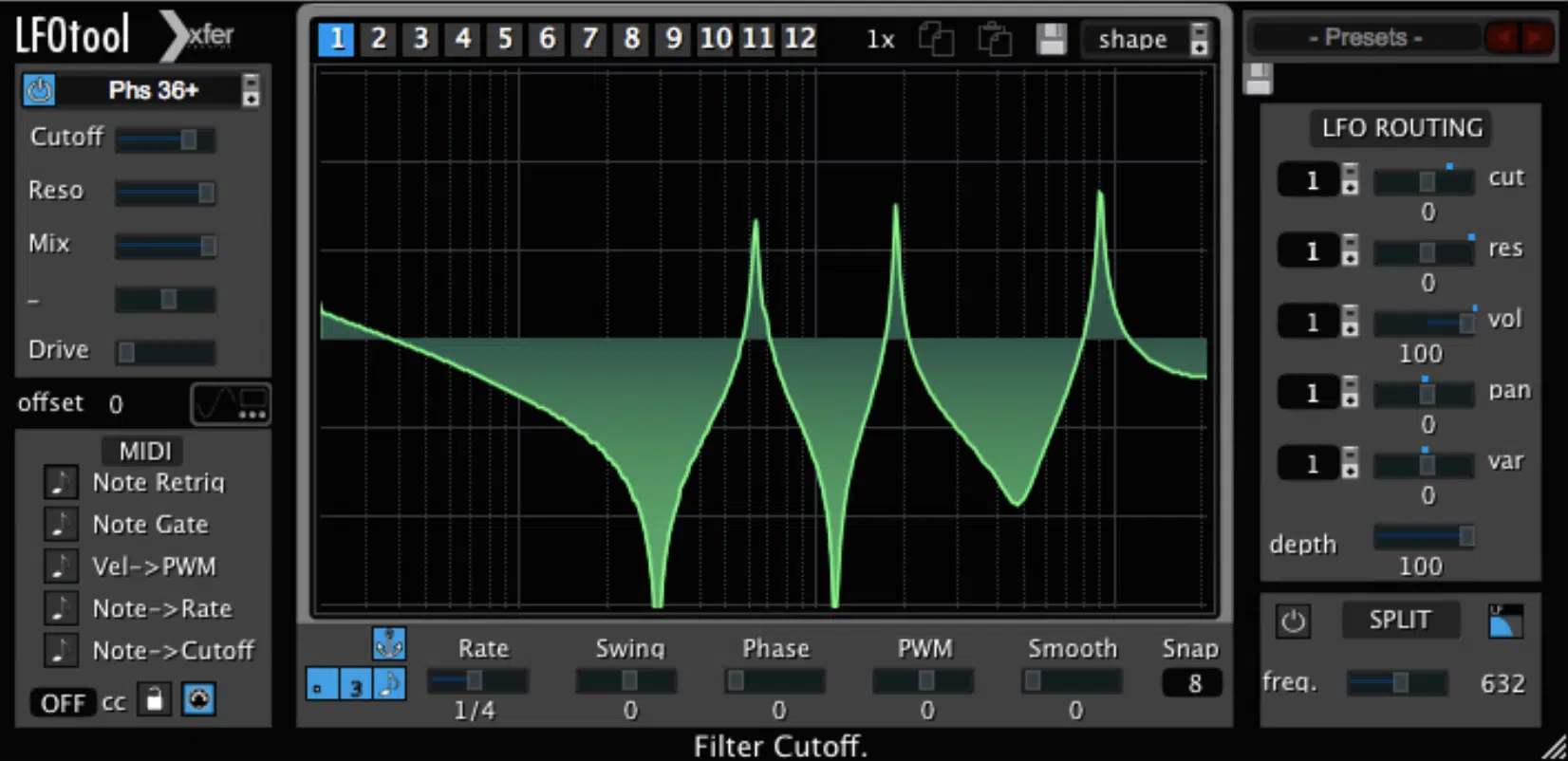
Effective use of filter and envelope settings is key to sculpting a synth bass sound.
- The filter cutoff frequency and resonance 一 Control the brightness and tonal quality of the bass.
- The envelope settings 一 Determine the sound’s attack, decay, sustain, and release characteristics.
A slow attack and moderate decay might be ideal for a smoother bass sound in pop music, while a fast attack and short decay are crucial for creating a punchy bass.
This is especially true in genres like techno or dubstep.
The filter envelope plays a significant role in shaping the dynamic contour of the bass sound.
Adjusting the contour amount can either accentuate or soften the impact of each note, allowing for greater expressive control.
NOTE: Adjusting the key velocity sensitivity on a synthesizer allows you to control the intensity of the bass sound dynamically.
This ensures that each note responds expressively to your touch.
For instance, a Reese bass in drum and bass tracks often features a pronounced filter envelope to emphasize its rhythmic nature.
While a sub-bass in hip-hop might have a subtler envelope setting to blend smoothly with the mix.
The Versatility of Synthesizers in Creating Synth Bass Sounds
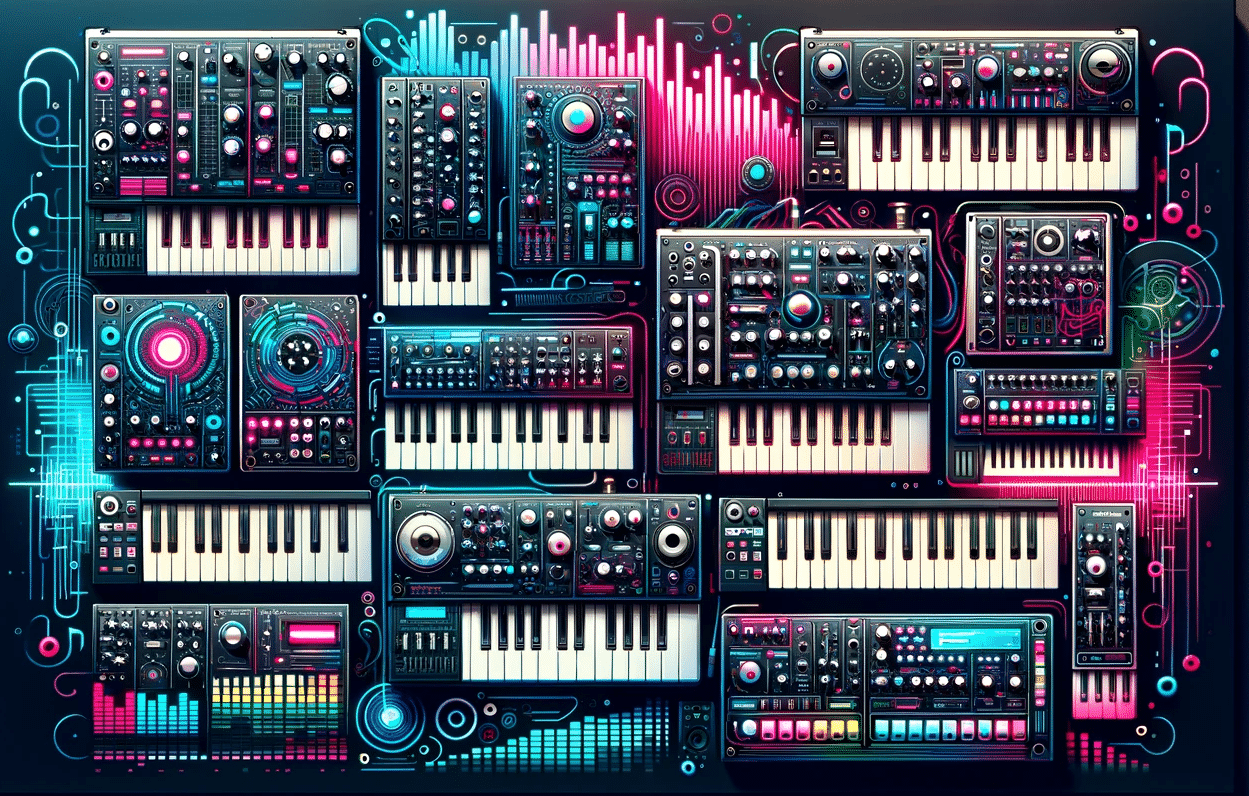
Synthesizers, in their many forms, are pivotal in shaping your synth bass sounds.
The inherent versatility of synthesizers (which we touched upon) allows you to experiment with a range of sonic textures.
This includes everything from emulating the natural resonance of traditional bass instruments to creating entirely new synth bass sounds.
The power of a synthesizer lies in its ability to blend traditional musicality with innovative sound design.
This is why a synth is great for discovering and creating bass sounds across any genre.
Whether it’s through an analog synth or digital synthesizer and factory presets, the potential to mold and refine bass tones is boundless.
This makes synthesizers an indispensable tool heard in most modern tracks.
The adaptability of a synthesizer in producing diverse synth bass sounds is a testament to their design and functionality.
Synthesizers, be it hardware synths or software-based synthesizers, provide a multitude of options for tweaking and fine-tuning bass sounds.
From being able to adjust oscillator types to manipulating filter envelopes, synthesizers enable producers to dive deep into sound sculpting.
The flexibility and freedom synths offer allow you to infuse your tracks with unique and memorable synth bass sounds.
Synths, in essence, are the backbone of contemporary bass sound production, continually pushing the boundaries.
Synth Bass: Final Thoughts
The world of synth bass offers an endless array of possibilities for music producers.
Whether you’re creating deep and resonant sub-bass lines or experimenting with the edgy textures of FM bass, understanding (and using) different synth bass sounds is key.
Synth bass sounds are not just components of your track; it’s a transformative element that can define the entire sound.
To further enhance your journey in synth bass production, don’t miss out on the Essential Free MIDI Basslines pack.
This invaluable resource provides 12 dynamic, free MIDI basslines, perfect for plugging and playing into your projects.
Each bassline in the pack is designed to be instantly impactful 一 offering a variety of styles that can complement any genre.
Plus, everything is 100% royalty-free, fully customizable, and compatible with your favorite sounds.
This pack offers endless inspiration that will open up new creative avenues and allow you to experiment and refine your synth bass skills.
As you continue to explore the expansive world of synth bass, remember that the key to mastering synth bass, in all its various forms, lies in experimentation and adaptation.
With resources like the Essential Free MIDI Basslines pack and the knowledge you’ve gained from this article, you’re well-equipped to create compelling, professional-quality basslines.
As well as captivating new listeners and finding your signature sound.
Until next time…







Leave a Reply
You must belogged in to post a comment.